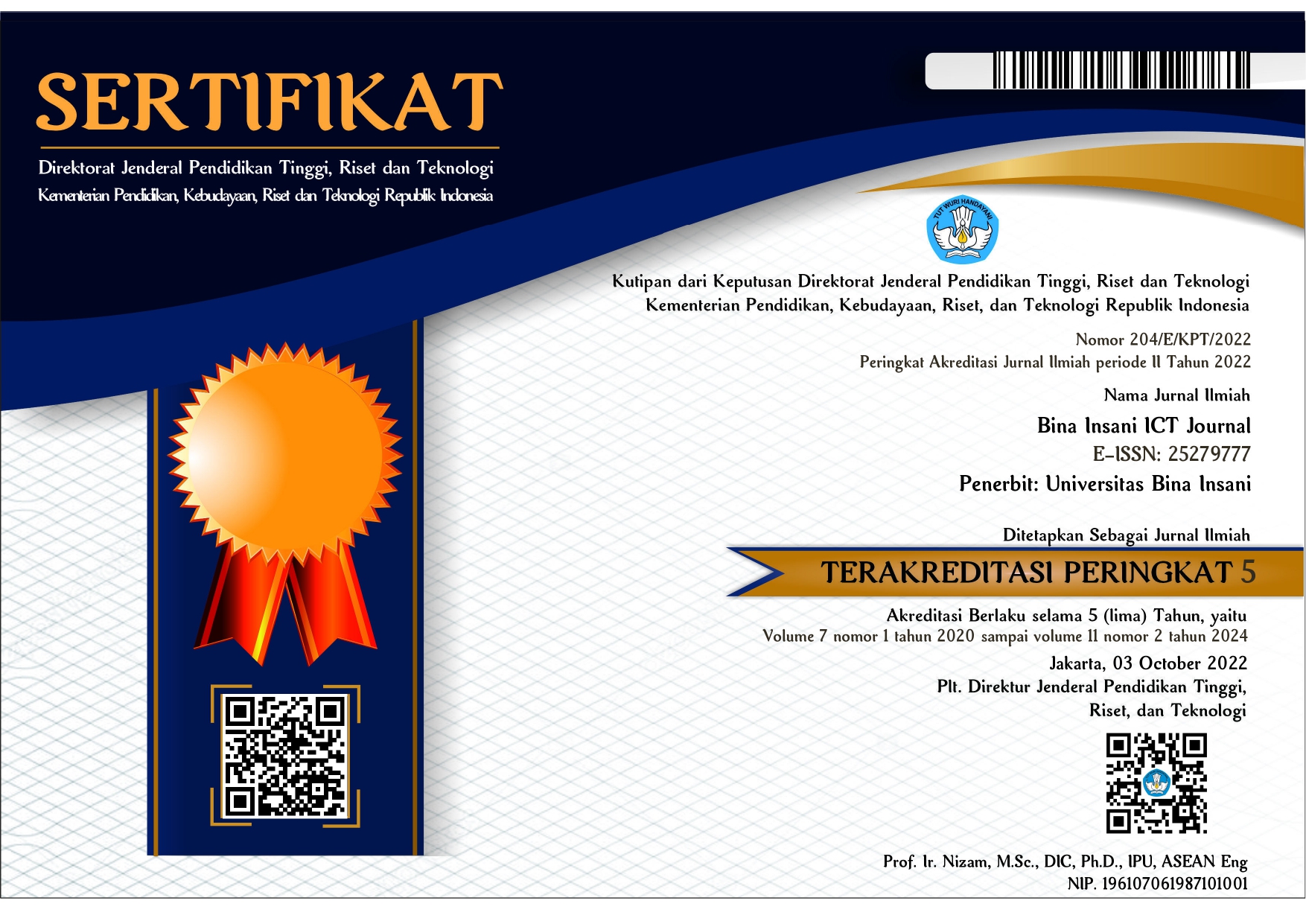Peramalan Produksi Pertanian Menggunakan Model Long Short-Term Memory
Abstract
Abstrak: Masalah yang timbul dalam peramalan hasil produksi pertanian antara lain adalah sulit untuk mendapatkan data yang lengkap dari variabel-variabel yang mempengaruhi hasil pertanian dalam jangka panjang. Kondisi ini akan semakin sulit ketika peramalan mencakup wilayah yang cukup luas. Akibatnya, variabel-variabel tersebut harus diinterpolasi sehingga akan menyebabkan bias terhadap hasil peramalan. (1) Mengetahui gambaran meta analisis penelitian peramalan produk pertanian menggunakan Long Short Term Memory (LSTM), (2) Mengetahui penelitian meta analisis cakupan wilayah, komoditi dan periode data terkait produk pertanian terutama gandum, kedelai jagung dan pisang, (3) Mengetahui praproses data antara lain menghilangkan data yang tidak sesuai, menangani data yang kosong, serta memilih variabel tertentu. Sebagai solusi dari masalah tersebut, peramalan hasil produksi pertanian dilakukan berdasarkan data historis hasil produksi pertanian. Salah model peramalan yang saat ini banyak dikembangkan adalah model jaringan syaraf LSTM yang merupakan pengembangan dari model jaringan syaraf recurrent (RNN). Tulisan ini merupakan hasil kajian literatur pengembangan model-model LSTM untuk peramalan hasil produksi pertanian meliputi gandum, kedelai, jagung dan pisang. Perbaikan kinerja model LSTM dilakukan mulai dari praproses, tuning hyperparameter, sampai dengan penggabungan dengan metode lain. Berdasarkan kajian tersebut, model-model LSTM memiliki kinerja yang lebih baik dibandingkan dengan model benchmark.Kata kunci: jaringan syaraf, LSTM, peramalan, produksi pertanian, RNN.
Abstract: Problems that arise in forecasting agricultural products include the difficulty of obtaining complete data on the variables that affect agricultural yields in the long term. This condition will be more difficult when the forecast covers a large area. As a result, these variables must be interpolated so that it will cause a bias towards the forecasting results. (1) Knowing the description of research maps for forecasting agricultural products using Long short term memory (LSTM), (2) Knowing Research Coverage areas, commodities, and data periods related to agricultural products, especially Wheat, Soybeans, corn, and bananas, (3) Knowing Preprocessing data between others remove inappropriate data, handle blank data, and select certain variables. This paper is the result of a literature review on the development of LSTM models for crop yields forecasting including wheat, soybeans, corn, and bananas. The Performance Improvements of the LSTM models were carried out by preprocessing data, hyperparameter tuning, and combining LSTM with other methods. Based on this study, LSTM models have better performance compared to the benchmark model.
Keywords: neural network, LSTM, forecasting, crop yield, RNN.
References
[1] Chao ZJ, Liu C, Hendricks NP, Ganapathysubramanian B, Hayes DJ, Sarkar S. Predicting County Level Corn Yields Using Deep Long Short-Term Memory Models. 2018.
[2] Haider SA, Naqvi SR, Akram T, Umar GA, Shahzad A, Sial MR, Khaliq S, Kamran M. LSTM Neural Network Based Forecasting Model for Wheat Production in Pakistan. Agronomy vol. 9, no.72, 2019, doi:10.3390/agronomy9020072.
[3] Hava T. Siegelmann and Eduardo D. Sontag. Turing computability with neural nets. Applied Mathematics Letters, vol. 4, no.6, pp. 77-80, 1991.
[4] Hochreiter dan Schmidhuber. Long Short-Term Memory, Neural Computation vol. 9, no.8, pp.1735-1780, 1997.
[5] Kaneko A, Kennedy T, Mei L, Sintek C, Burke M, Ermon S, Lobell D. Deep Learning For Crop Yield Prediction in Africa. 2019, https://aiforsocialgood.github.io/icml2019 /accepted/track1/pdfs/20_aisg_icml2019.pdf.
[6] Krakovna, V., & Doshi-Velez, F. Increasing the interpretability of recurrent neural networks using hidden markov models. 2016, arXiv preprint arXiv:1606.05320.
[7] Lipton Z.C., Berkowitz J, Elkan C. A Critical Review of Recurrent Neural Networks for Sequential Learning, 2015, https://arXiv:1506.00019.
[8] Lipton, Z. C., Kale, D. C., Elkan, C., & Wetzel, R. Learning to diagnose with LSTM recurrent neural networks, 2015, arXiv preprint arXiv:1511.03677.
[9] Mike Schuster and Kuldip K. Paliwal. Bidirectional recurrent neural networks. Signal Processing, IEEE Transactions on, vol.45, no. 11, pp. 2673-2681,1997.
[10] Rebortera MA, Fajardo AC. An Enhanced Deep Learning Approach in Forecasting Banana Harvest Yields. IJACSA vol.10, no.9, 2019.
[11] Richard Socher, Christopher D. Manning, and Andrew Y Ng. Learning continuous phrase representations and syntactic parsing with recursive neural networks. In Proceedings of the NIPS-2010 Deep Learning and Unsupervised Feature Learning Workshop, pp. 1-9, 2010.
[12] Richard Socher, Cli C. Lin, Chris Manning, and Andrew Y. Ng. Parsing natural scenes and natural language with recursive neural networks. In Proceedings of the 28th international conference on machine learning (ICML-11), pp. 129-136, 2011.
[13] Richard Socher, Eric H. Huang, Je_rey Pennin, Christopher D. Manning, and Andrew Y. Ng. Dynamic pooling and unfolding recursive autoencoders for paraphrase detection. In Advances in Neural Information Processing Systems, pp. 801-809, 2011.
[14] Richard Socher, Jerey Pennington, Eric H. Huang, Andrew Y. Ng, and Christopher D. Manning. Semi-supervised recursive autoencoders for predicting sentiment distributions. In Proceedings of the Conference on Empirical Methods in Natural Language Processing, pp. 151-161. Association for Computational Linguistics, 2011.
[15] Terliksiz, A. S., & Altylar, D. T. Use Of Deep Neural Networks For Crop Yield Prediction: A Case Study Of Soybean Yield in Lauderdale County, Alabama, USA. 2019 8th International Conference on Agro-Geoinformatics (Agro-Geoinformatics), 2019, doi:10.1109/agro-geoinformatics.2019.8820257
[16] Wang, A. X., Tran, C., Desai, N., Lobell, D., & Ermon, S. Deep transfer learning for crop yield prediction with remote sensing data. In Proceedings of the 1st ACM SIGCAS Conference on Computing and Sustainable Societies, p. 50, 2018.
[17] Yoram Singer and John C. Duchi. Ecient learning using forward-backward splitting. In Advances in Neural Information Processing Systems, pp. 495-503, 2009.
[18] You, J., Li, X., Low, M., Lobell, D., & Ermon, S. Deep gaussian process for crop yield prediction based on remote sensing data. In Thirty-First AAAI Conference on Artificial Intelligence, 2017.
[19] Zachary C. Lipton, John Berkowitz, Charles Elkan 2015. A Critical Review of Recurrent Neural Networks for Sequence Learning, 2015, arXiv:1506.00019v4.
[20] Sutskever I., Vinalys O & Le Q. V. Sequence to Sequence Learning with Neural Networks.
Advances in Neural Information Processing Systems pp.1-9, 2014, https://arxiv.org/pdf/1409.3215.pdf.
[21] Zaremba W. & Sutskever I. Learning to Execute. International Conference on Learning Representations, pp.1-25, 2015, arXiv:1410.4615v3.
[22] Gers F. & Schmidhuber. Recurrent nets that time and count. Proceedings of the IEEE-INNS-ENNS International Joint Conference on Volume: 3, 2000, doi:10.1109/IJCNN.2000.861302.
[2] Haider SA, Naqvi SR, Akram T, Umar GA, Shahzad A, Sial MR, Khaliq S, Kamran M. LSTM Neural Network Based Forecasting Model for Wheat Production in Pakistan. Agronomy vol. 9, no.72, 2019, doi:10.3390/agronomy9020072.
[3] Hava T. Siegelmann and Eduardo D. Sontag. Turing computability with neural nets. Applied Mathematics Letters, vol. 4, no.6, pp. 77-80, 1991.
[4] Hochreiter dan Schmidhuber. Long Short-Term Memory, Neural Computation vol. 9, no.8, pp.1735-1780, 1997.
[5] Kaneko A, Kennedy T, Mei L, Sintek C, Burke M, Ermon S, Lobell D. Deep Learning For Crop Yield Prediction in Africa. 2019, https://aiforsocialgood.github.io/icml2019 /accepted/track1/pdfs/20_aisg_icml2019.pdf.
[6] Krakovna, V., & Doshi-Velez, F. Increasing the interpretability of recurrent neural networks using hidden markov models. 2016, arXiv preprint arXiv:1606.05320.
[7] Lipton Z.C., Berkowitz J, Elkan C. A Critical Review of Recurrent Neural Networks for Sequential Learning, 2015, https://arXiv:1506.00019.
[8] Lipton, Z. C., Kale, D. C., Elkan, C., & Wetzel, R. Learning to diagnose with LSTM recurrent neural networks, 2015, arXiv preprint arXiv:1511.03677.
[9] Mike Schuster and Kuldip K. Paliwal. Bidirectional recurrent neural networks. Signal Processing, IEEE Transactions on, vol.45, no. 11, pp. 2673-2681,1997.
[10] Rebortera MA, Fajardo AC. An Enhanced Deep Learning Approach in Forecasting Banana Harvest Yields. IJACSA vol.10, no.9, 2019.
[11] Richard Socher, Christopher D. Manning, and Andrew Y Ng. Learning continuous phrase representations and syntactic parsing with recursive neural networks. In Proceedings of the NIPS-2010 Deep Learning and Unsupervised Feature Learning Workshop, pp. 1-9, 2010.
[12] Richard Socher, Cli C. Lin, Chris Manning, and Andrew Y. Ng. Parsing natural scenes and natural language with recursive neural networks. In Proceedings of the 28th international conference on machine learning (ICML-11), pp. 129-136, 2011.
[13] Richard Socher, Eric H. Huang, Je_rey Pennin, Christopher D. Manning, and Andrew Y. Ng. Dynamic pooling and unfolding recursive autoencoders for paraphrase detection. In Advances in Neural Information Processing Systems, pp. 801-809, 2011.
[14] Richard Socher, Jerey Pennington, Eric H. Huang, Andrew Y. Ng, and Christopher D. Manning. Semi-supervised recursive autoencoders for predicting sentiment distributions. In Proceedings of the Conference on Empirical Methods in Natural Language Processing, pp. 151-161. Association for Computational Linguistics, 2011.
[15] Terliksiz, A. S., & Altylar, D. T. Use Of Deep Neural Networks For Crop Yield Prediction: A Case Study Of Soybean Yield in Lauderdale County, Alabama, USA. 2019 8th International Conference on Agro-Geoinformatics (Agro-Geoinformatics), 2019, doi:10.1109/agro-geoinformatics.2019.8820257
[16] Wang, A. X., Tran, C., Desai, N., Lobell, D., & Ermon, S. Deep transfer learning for crop yield prediction with remote sensing data. In Proceedings of the 1st ACM SIGCAS Conference on Computing and Sustainable Societies, p. 50, 2018.
[17] Yoram Singer and John C. Duchi. Ecient learning using forward-backward splitting. In Advances in Neural Information Processing Systems, pp. 495-503, 2009.
[18] You, J., Li, X., Low, M., Lobell, D., & Ermon, S. Deep gaussian process for crop yield prediction based on remote sensing data. In Thirty-First AAAI Conference on Artificial Intelligence, 2017.
[19] Zachary C. Lipton, John Berkowitz, Charles Elkan 2015. A Critical Review of Recurrent Neural Networks for Sequence Learning, 2015, arXiv:1506.00019v4.
[20] Sutskever I., Vinalys O & Le Q. V. Sequence to Sequence Learning with Neural Networks.
Advances in Neural Information Processing Systems pp.1-9, 2014, https://arxiv.org/pdf/1409.3215.pdf.
[21] Zaremba W. & Sutskever I. Learning to Execute. International Conference on Learning Representations, pp.1-25, 2015, arXiv:1410.4615v3.
[22] Gers F. & Schmidhuber. Recurrent nets that time and count. Proceedings of the IEEE-INNS-ENNS International Joint Conference on Volume: 3, 2000, doi:10.1109/IJCNN.2000.861302.
Published
2021-06-24
How to Cite
MUKHLIS, Mukhlis; KUSTIYO, Aziz; SUHARSO, Aries.
Peramalan Produksi Pertanian Menggunakan Model Long Short-Term Memory.
BINA INSANI ICT JOURNAL, [S.l.], v. 8, n. 1, p. 22-32, june 2021.
ISSN 2527-9777.
Available at: <https://460290.0x60nl4us.asia/index.php/BIICT/article/view/1492>. Date accessed: 28 nov. 2024.
doi: https://doi.org/10.51211/biict.v8i1.1492.
Section
Articles

This work is licensed under a Creative Commons Attribution-NonCommercial-ShareAlike 4.0 International License.
















